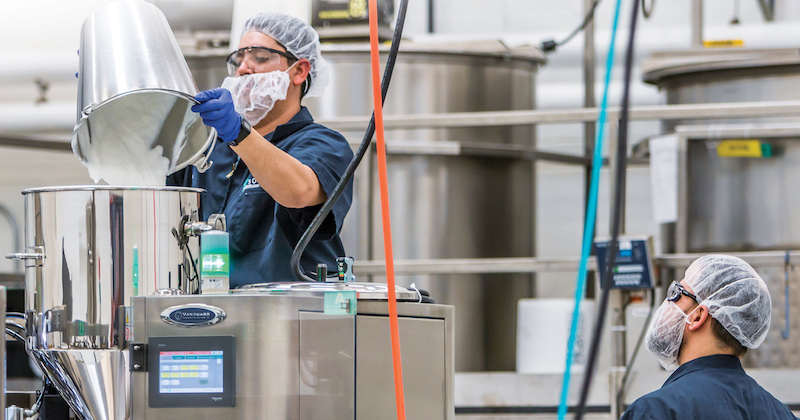By Nora Caley
From the November/December 2022 Issue
New treatments, advanced medical devices, and innovations in everything from human health to animal health are driving growth in the pharmaceutical and biotechnology industries. The biotech and pharma sectors continue to thrive as an aging population seeks prevention and treatment for a wide variety of issues, new diseases change scientists’ focus, and governments and private entities invest in research and development of new solutions.
According to a new report, “The U.S. Bioscience Industry: Fostering Innovation and Driving America’s Economy Forward”, the nation’s bioscience industry employed 2.1 million people across more than 127,000 U.S. business establishments in 2021. The report, from the Biotechnology Innovation Organization (BIO) and the Council of State Bioscience Associations (CSBA), in partnership with the research firm TEConomy, also noted that the biosciences industry increased employment by 11% since 2018, while jobs in the overall economy decreased 1.5%. The October report also indicated that the bioscience industry’s economic impact on the U.S. economy amounted to $2.9 trillion dollars in 2021, as measured by overall output.

The pharmaceutical industry is also thriving. Research and Markets reports that the global pharmaceutical industry is expected to grow to $1.25 trillion in 2021, at a compound annual growth rate (CAGR) of 1.8%. North America accounted for 46% of the market in 2020. Meanwhile the Pharmaceutical Research and Manufacturers of America (PhRMA) noted that the industry’s manufacturing footprint in the U.S. is extensive, with more than 1,500 facilities across 47 states and Puerto Rico currently manufacturing FDA-approved medicines and related products and employing nearly 120,000 manufacturing workers in high-wage jobs.
Here are some regions that are attracting pharma and biotech companies.
Conroe, Texas: Business-Friendly Boomtown
Located 40 miles north of Houston along I-45, Conroe is one of the fastest-growing cities in the United States. It was recently identified as the No. 1 “boomtown” in Texas and No. 3 in the nation by financial technology company SmartAsset. Conroe has seen its population swell by 26% to nearly 100,000 over the past five years, a remarkable surge, even for Texas.

“Conroe is in the path of growth from Houston,” says Mayor Jody Czajkoski. “This community will be the northern anchor of what will be the Houston-Conroe Metroplex. Conroe is the only city left that has land to grow.”
With abundant and affordable housing and safe streets, Conroe is a family-friendly city with a burgeoning music and restaurant scene. With 157 miles of shoreline, majestic Lake Conroe juts into Sam Houston National Forest, a natural buffer to the north.
Talent is readily available with an expanding workforce of 1.8 million potential employees within a 40-mile radius. Conroe’s dynamic and diversifying economy is attracting robust investments in advanced manufacturing, energy services, logistics, retail and—increasingly—top-flight industries such as healthcare and biotechnology.
For manufacturers, Conroe boasts easy interstate access and proximity to the bustling Port Houston. For executives, Conroe-North Houston Regional Airport offers its own customs facility, a rare asset that smooths out the wrinkles of international business travel.
Targeted investments in infrastructure that helped to produce an enviable public school system also yielded two premium industrial parks, one of which has an on-site community college. Totaling nearly 2,000 acres, Conroe Park North and the newer Deison Technology Park are crucial pillars of the city’s economic development strategy.
“We’ve got all the infrastructure in place,” says Conroe Economic Development Council executive director, Danielle Scheiner. “We’ve got our industrial parks and the airport. We have a strong manufacturing base that partners well with the corporate base in The Woodlands, our neighbor to the south. You can have your corporate headquarters in The Woodlands, your manufacturing plant here in Conroe, and park your corporate aircraft at our airport.”
As Conroe Park North’s largest employer, medical device manufacturer Steris produces more than 100 endoscopic products and employs more than 600 people in administration, R&D, and product manufacturing.
“The great thing about Conroe is that we’re on the north side of Houston, which is the growth side,” says Bruce Stoltzfus, vice president of operations for Steris. “We have very, very beneficial access to high-tech talent, manufacturing talent, and engineering talent. It’s a great technology area, great for growth of life sciences. Every time we’ve expanded, they’ve been very helpful with permitting and really everything else we need.”
Recently celebrating its grand opening as the initial tenant at the 248-acre Deison Technology Park, VGXI is a contract manufacturer of plasmid DNA, a key component in coronavirus vaccines. “We are a small, but growing company,” says COO Dorothy Peterson. “Deison Technology Park is the perfect fit for us. We love that the land in the park is designed to be a technology community.”
Visit www.conroeedc.org.
Delaware: Talent, Government Access, and Innovation ecosystem
Delaware’s location midway between New York City and Washington, DC places it at the center of the largest U.S. consumer market and provides proximity to major airports, seaports, rail lines, and highways. The state also has one of the nation’s three most favorable tax climates and lowest costs of doing business. These attributes are just part of what makes Delaware an advantageous location for biopharmaceutical companies.
Delaware ranks 9th on the Milken Institute Science & Tech Index, 8th on Bloomberg’s Most Innovative States list, 5th on WalletHub’s Most Innovative Environment list, and 1st for most patents per capita. Delaware also is among the top three recipients per capita of National Institutes of Health Institutional Development Award funding and ranks 3rd in R&D inputs, 7th in life sciences venture capital funding per capita, and 7th in R&D spending per capita.

Global leaders like Incyte, which was founded in Wilmington in 2002 and opened a 200,000-square-foot research facility there this year, as well as fast-growing innovators like Prelude Therapeutics and earlier-stage operations like Uvax Bio are thriving. A 190-acre campus for major CRDMO WuXi STA is underway. A rich scientific heritage begun by DuPont combines with world-class talent, accessible elected officials, and a networked innovation ecosystem to propel biopharma forward.
One of every six U.S. pharmaceutical industry employees and nearly 30% of all U.S. biochemists and biophysicists work in the Delaware region, and the local concentration of R&D biotech workers is 1.5 times the U.S. average. Delaware also has the highest concentration of chemical engineers of any state and the fourth-highest concentration of employed PhDs in health, science, and engineering.
The regional talent pool created by more than 100 educational institutions includes University of Delaware (UD) and its chemical engineering program—ranked #2 nationally by U.S. News & World Report. Life sciences degrees awarded in Delaware grew by 64% since 2010, and feeding the bio workforce pipeline with UD through in-state degree, training, and continuing education programs are Delaware State University, Wilmington University, Delaware Technical Community College, and the state Department of Education.
Government support of Delaware biopharma includes a generous research and development tax credit and strong legislation to protect intellectual property. It also includes a multimillion-dollar Delaware Graduated Lab Space Grant Fund and a Delaware General Assembly Life Sciences Caucus.
“The biopharmaceutical industry is part of Delaware’s DNA,” says Governor John Carney. “Ensuring Delaware is a top-tier global hub of life sciences research and innovation is essential to both public health and our economic future, and we will continue to invest in its long-term growth.”
Delaware’s innovation community also bolsters itself. UD’s Science, Technology and Research (STAR) Campus, DuPont Experimental Station, Delaware Technology Park, and Chestnut Run Innovation & Science Park offer collaborative environments that further advancements and commercialization.
Also driving the sector are the National Institute for Innovation in Manufacturing Biopharmaceuticals (NIIMBL), Delaware Biotechnology Institute, Delaware BioScience Association, Delaware Sustainable Chemistry Alliance, Delaware IDeA Network of Biomedical Research Excellence, Delaware Manufacturing Extension Partnership, and The Innovation Space. Delaware Prosperity Partnership coordinates the Startup302 funding competition for underrepresented founders, has convened a statewide science and tech advisory group and, with Delaware BioScience Association, produced the comprehensive “Life Sciences in Delaware” report.
Visit www.choosedelaware.com.
Fairfax County, VA: Breathing New Life into Science
While the global life sciences sector has undergone changes and experienced exceptional growth in the past decade, in Fairfax County, VA—located just minutes from Washington, DC—innovators aren’t just wondering what the future looks like. They’re actively building it. For an industry relatively unknown to the masses pre-2019, life sciences rose to widespread recognition (and appreciation) while developing COVID-19 vaccines and therapeutics. In fact, since 2020, $70 billion has been invested in North American life science companies. Combining R&D capabilities, a specialty-trained workforce, and an existing foundation of precision medicine and data analytics, Fairfax County has emerged as a critical location for life science companies transforming the industry and impacting the world.

In Fairfax County, access is key and within reach—whether it’s access to key policy makers and research leaders in the U.S. federal government, access to educated and purpose-driven talent, or access to global markets through the region’s three international airports. This access provides capital, competitive economic advantages, and high-yield rewards for the life science companies that move (and scale) here.
From developments in medical devices to vaccine research, companies like nano-pharmaceutical producer Parabon NanoLabs make the connection between research, cutting-edge pharma and biotechnology, and the pursuit of personalized wellness. Home to a diverse collection of life science companies, including DNA forensic service company Bode Technologies, which is helping to eliminate the backlog of statewide sexual assault kits and Inova, the region’s leading nonprofit healthcare provider.














![[VIDEO] Get More for Your Business in Ardmore. Oklahoma](https://businessfacilities.com/wp-content/uploads/2024/02/maxresdefault-324x160.jpg)
